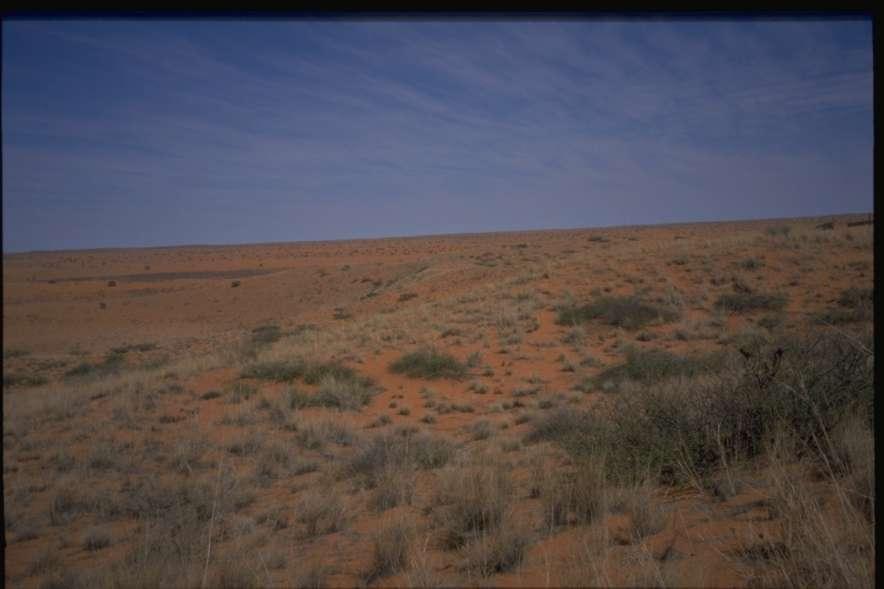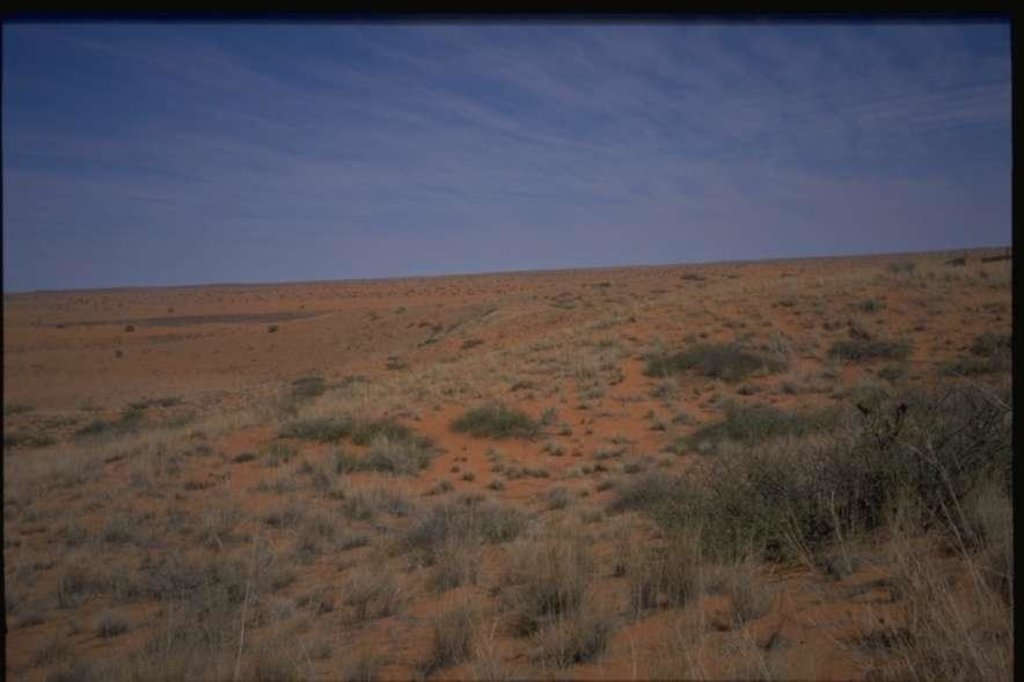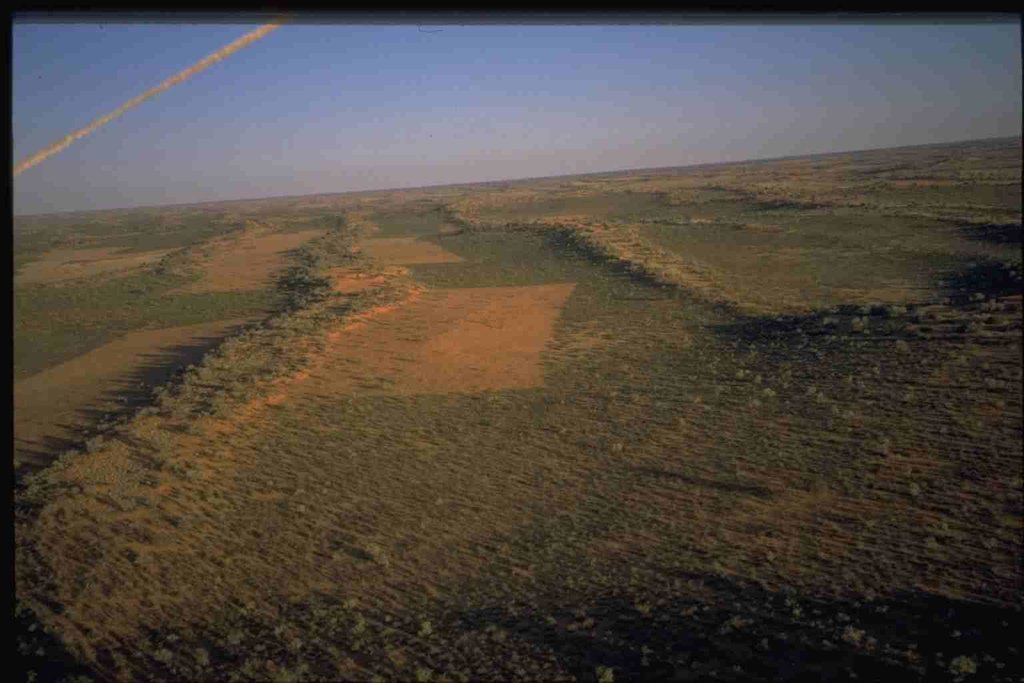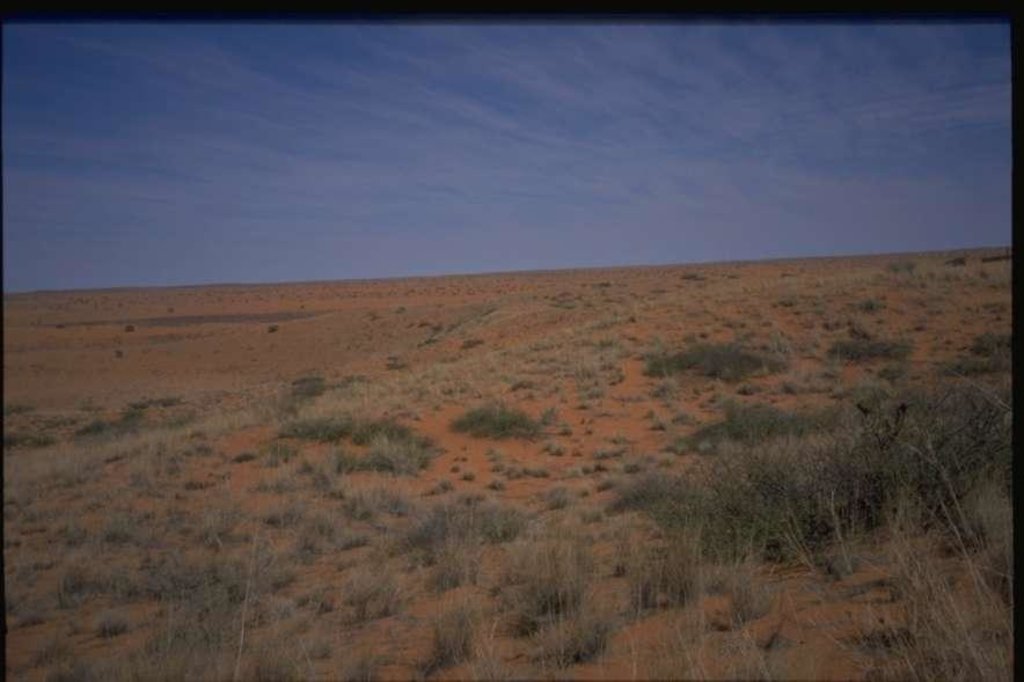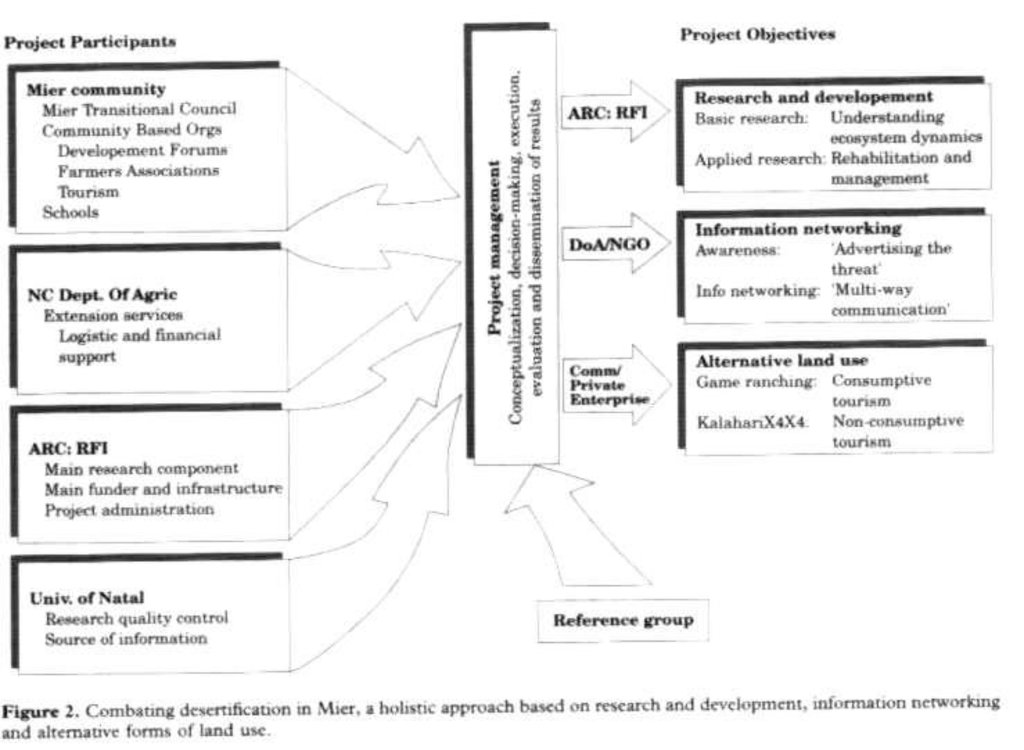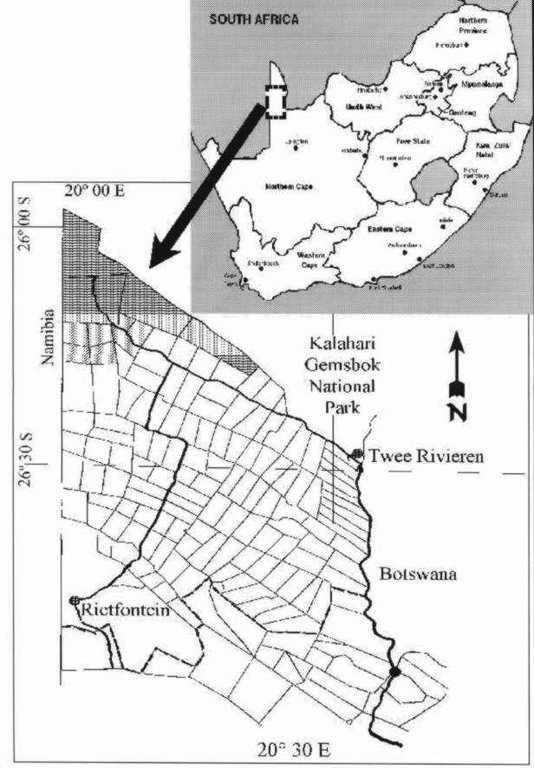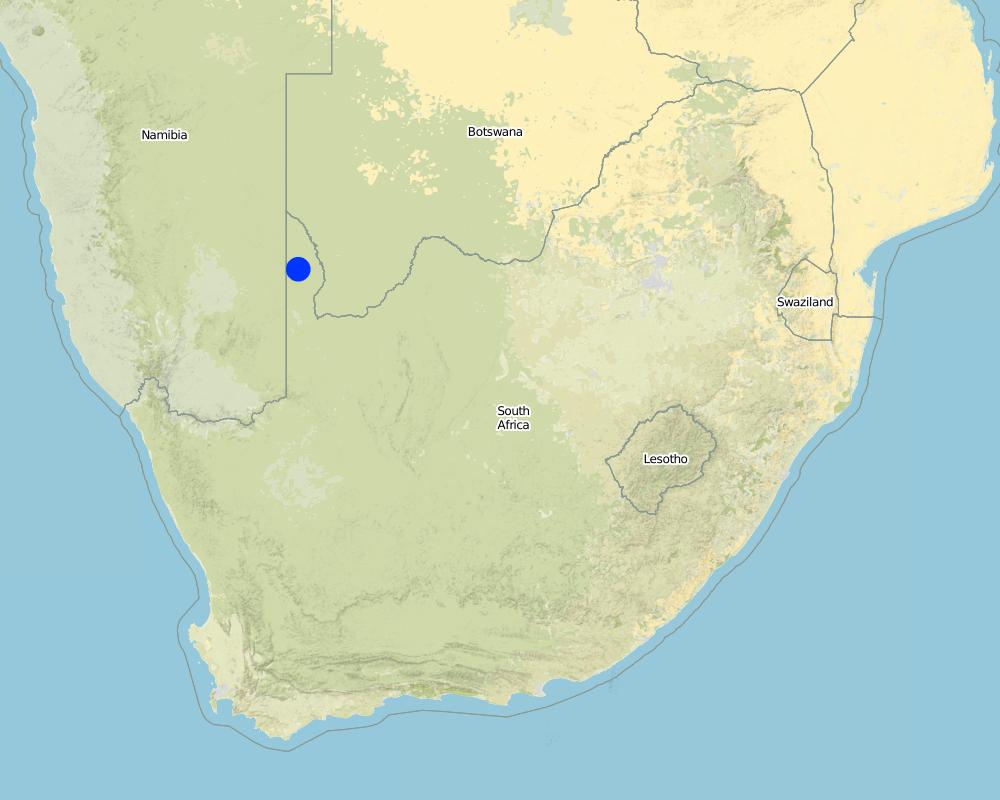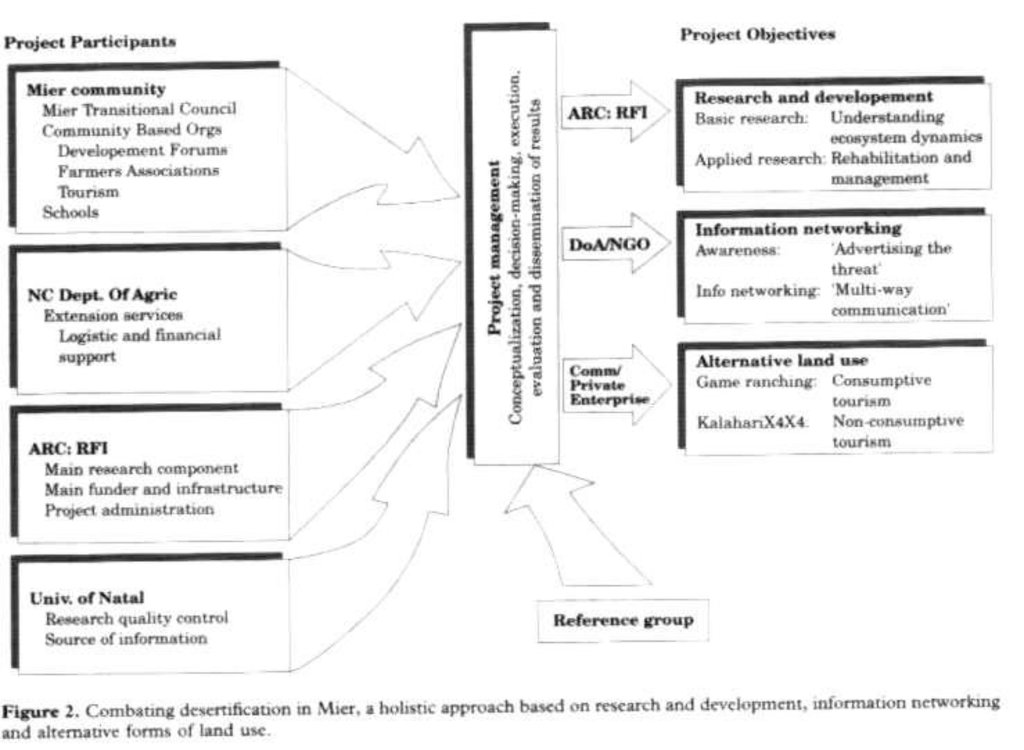Rehabilitation techniques in southern Kalahari - Vegetative and Management [南非]
- 创建:
- 更新:
- 编制者: Andre F. Van Rooyen
- 编辑者: –
- 审查者: Fabian Ottiger
approaches_2335 - 南非
查看章节
全部展开 全部收起1. 一般信息
1.2 参与方法评估和文件编制的资源人员和机构的联系方式
SLM专业人员:
Smith Desmond
054-4611415
Northern Cape. Department of Agriculture
南非
有助于对方法进行记录/评估的机构名称(如相关)
Dept. of Agriculture, Northern Cape (Dept. of Agriculture, Northern Cape) - 南非1.3 关于使用通过WOCAT记录的数据的条件
编制者和关键资源人员接受有关使用通过WOCAT记录数据的条件。:
是
2. SLM方法的描述
2.1 该方法的简要说明
Shared interest by Mier Management Council and Provincial Department of Agriculture
2.2 该方法的详细说明
该方法的详细说明:
Aims / objectives: Initially a combined effort by Department of Agriculture and Mier Management Council to combat degradation of game camps. Directed towards a male dominated farming community, also involving a few females (ages ranging from middle to old age). An objective was to educate towards awareness to degradation and techniques involving the rehabilitation of these areas and the prevention of getting to this state. Also including methods which prevent returning to this state. Initially using farmer???s days - education. Research came later, focussing on understanding the ecology of the area and then to concentrate on rehabilitation techniques. This was later introduced in farmer???s days, school education and education of management council. Stages of implementation: 1) Realisation by management council that veld was degraded. 2) Department of Agriculture requested to assist ??¡§ in the form of trial and error (i.e. resting camps, poisoning of shrubs). 3) Resting of camps showed no improvement, so Department requested assistance from Agricultural Research Council (Range and Forage Institute) to gain understanding of ecology of area. 4) Once understanding gained and techniques developed, education in the form of farmer???s days, school days and management council. Role of participants: 1) Nature Conservation: Initially involved in game number management. 2) Department of Agriculture: Advisory capacity management of techniques. 3) ARC - Research and advisory. 4) Management council ??¡§ labour control. 5) Community - involved through council in decision-making ??¡§ also jobs provided through labour.
2.3 该方法的照片
2.5 采用该方法的国家/地区/地点
国家:
南非
区域/州/省:
Northern Cape
Map
×2.6 该方法的开始和终止日期
注明开始年份:
1988
2.7 方法的类型
- 基于项目/方案
2.8 该方法的主要目的/目标
The Approach focused mainly on SLM with other activities (Income generation for tax subsidy in the community, job creation for males in the community, land care, development of eco-tourism, collaboration with local leadership)
Education ??¡§ in techniques to combat desertification, also in prevention of degradation Financial empowerment Management techniques
The SLM Approach addressed the following problems: Finance, education (very little education with regards to labours)
2.9 推动或妨碍实施本办法所适用的技术的条件
财务资源和服务的可用性/可得性
- 阻碍
Very poor community
Treatment through the SLM Approach: Landcare (money)
机构设置
- 阻碍
Financial - no money in Institute and Department
Treatment through the SLM Approach: Money
法律框架(土地使用权、土地和水使用权)
- 启动
The existing land ownership, land use rights / water rights moderately helped the approach implementation: Hinder: moderate Farm-government won???t allow farmers to own land so attitude can be negative. Community reaps benefits from game farms.
其他
- 阻碍
Political: leads to mistrust and uneasiness w.r.t. Money
Treatment through the SLM Approach: Work on the problem at hand and ignore politics
3. 相关利益相关者的参与和角色
3.1 该方法涉及的利益相关者及其职责
- 当地土地使用者/当地社区
Working land users were mainly men (Women did not work on project because of long distance to work).
Labour, management.
Labour work far too heavy for women (injuries have occurred). Women are directed towards cultivation techniques of Harpagophytum procumbens or basic homeskills (sewing etc.) Males - chopping & packing Rhigozum on dunes (degraded dunes).
- 教师/学龄儿童/学生
- NGO
Research, management, education
- 国家政府(规划者、决策者)
Funding
3.2 当地土地使用者/当地社区参与该方法的不同阶段
| 当地土地使用者/当地社区的参与 | 指定参与人员并描述活动 | |
|---|---|---|
| 启动/动机 | 被动 | workshops/seminars, public meetings; Discussions to indicate where researchers see the project going and how the land users would like to see it go. |
| 计划 | 互动 | workshops/seminars, public meetings; Field workshops & meetings-discuss how and where the project should be carried out. |
| 实施 | 外部支持 | responsibility for major steps; Labour used for bushpacking responsibility for LandCare committee for salaries and labour. |
| 监测/评估 | 无 | public meetings,measurements/observations, reporting, workshop/seminars; Monitoring of project is on going by researchers with help of few labours. Congresses/workshops are used to describe process & public meetings allow community to be informed. |
| Research | 无 | on-station; On-farm & on-station is ongoing. Lab work for information on germination processes. |
3.3 流程图(如可用)
3.4 有关SLM技术选择的决策
具体说明谁有权决定选择要实施的技术:
- 主要是SLM专家,咨询土地使用者之后
解释:
land user driven (bottom-up). Knowledge of the area
Decisions on the method of implementing the SLM Technology were made by mainly by SLM specialists with consultation of land users. directive (top-down). Management due to low education
4. 技术支持、能力建设和知识管理
4.1 能力建设/培训
是否为土地使用者/其他利益相关者提供培训?:
是
明确受训人员:
- 土地使用者
- school children/students, planners, politicians/decision makers
培训形式:
- 农民对农民
- 示范区域
涵盖的主题:
Rehabilitation ecological processes, cultivation, preventative agriculture
4.2 咨询服务
土地使用者有权使用咨询服务吗?:
是
指明是否提供了咨询服务:
- 在土地使用者的土地上
- 在固定中心
说明/注释:
Name of method used for advisory service: Not formal approach; Key elements: Education, Labour, Development; 1) Advisory service was carried out through: government's existing extension system Extension staff: mainly government employees 3) Target groups for extension: land users, school children/students; Activities: Bushpacking techniques, education; Education
Advisory service is inadequate to ensure the continuation of land conservation activities; The project is still in first phase - next phase will include female portion of community.
4.3 机构强化(组织发展)
是否通过这种方法建立或加强了机构?:
- 是,少许
具体说明机构的强化或建立程度:
- 本地
具体说明支持类型:
- 设备
- advise
4.4 监测和评估
监测和评估是该方法的一部分吗?:
是
注释:
bio-physical aspects were regular monitored through measurements
technical aspects were ad hoc monitored through observations
socio-cultural aspects were ad hoc monitored hrough observations
economic / production aspects were regular monitored through measurements
area treated aspects were regular monitored through measurements
no. of land users involved aspects were ad hoc monitored through observations
management of Approach aspects were ad hoc monitored through observations
There were few changes in the Approach as a result of monitoring and evaluation: Packing designs of Rhigozum plants on bare dunes. The less expensive, most efficient design was chosen.
4.5 研究
研究是该方法的一部分吗?
是
明确话题:
- 生态学
提供进一步的细节,并指出是谁做的研究:
Rehabilitation techniques must fall within the capabilities and finance of the community.
Research was carried out on-farm
5. 融资和外部物质支持
5.1 该方法中SLM组成部分的年度预算
注释(例如主要的资助来源/主要捐助者):
Approach costs were met by the following donors: government (national): 80.0%; local community / land user(s) (-): 20.0%
5.2 为土地使用者提供财政/物质支援
土地使用者是否获得实施该技术的财政/物质支持?:
是
5.3 对特定投入的补贴(包括劳动力)
- 设备
| 具体说明哪些投入得到了补贴 | 程度如何 | 对补贴做出具体说明 |
|---|---|---|
| 机械 | 充分融资 | |
| 工具 | 充分融资 | |
- 农业
| 具体说明哪些投入得到了补贴 | 程度如何 | 对补贴做出具体说明 |
|---|---|---|
| 种子 | 充分融资 | |
| 化肥 | 充分融资 | |
- 其它
| 其它(具体说明) | 程度如何 | 对补贴做出具体说明 |
|---|---|---|
| Food and transport | 充分融资 |
如果土地使用者的劳动力是一项重要的投入,那么是不是:
- 以现金支付
6. 影响分析和结论性陈述
6.1 方法的影响
该方法是否帮助土地使用者实施和维护SLM技术?:
- 否
- 是,很少
- 是,中等
- 是,支持力度很大
Stabilisation of dunes, greater vegetation on dunes.
该方法是否改善了阻碍SLM技术实施的土地使用权/用户权问题?:
- 否
- 是,很少
- 是,中等
- 是,支持力度很大
Farmers realised the simplicity of rehabilitation. The problem is likely to be overcome in the near future. Attitudes would change if government allowed ownership of land.
Did other land users / projects adopt the Approach?
- 否
- 是,很少
- 是,中等
- 是,支持力度很大
South Africa railways - lines which cut through dune systems
6.3 方法活动的可持续性
土地使用者能否维持通过该方法实施的措施(无外部支持的情况下)?:
- 是
6.4 该方法的长处/优点
| 土地使用者眼中的长处/优势/机会 |
|---|
| Own input into R &D |
| 编制者或其他关键资源人员认为的长处/优势/机会 |
|---|
| Community participation (How to sustain/ enhance this strength: Greater responsibility to community) |
| Healthy integration of Scientists & Community action (How to sustain/ enhance this strength: Good communication (Scientists & Community)) |
6.5 该方法的弱点/缺点以及克服它们的方法
| 土地使用者认为的弱点/缺点/风险 | 如何克服它们? |
|---|---|
| I do not know |
| 编制者或其他关键资源人员认为的弱点/缺点/风险 | 如何克服它们? |
|---|---|
| Slow recovery of natural resources | I don't think there is a way to increase reaction time in this area |
7. 参考和链接
7.1 方法/信息来源
- 实地考察、实地调查
- 与土地使用者的访谈
链接和模块
全部展开 全部收起链接
无链接
模块
无模块


